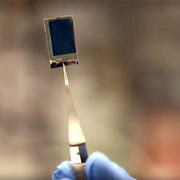Photosynthesis is a natural process in plants that convert water, sunlight and carbon dioxide into carbohydrate and oxygen. Plants are smart enough to use the renewable sources to get energy and store it in the form of starch.
In plants, the green pigment chlorophyll captures sunlight. In the presence of sunlight, a number of proteins help in the action of splitting water into hydrogen and oxygen along with an electron. Oxygen is released as by-product and Hydrogen reacts with carbon in carbon dioxide to form carbohydrates. For years, scientists have been working on bio-mimicking the process of photosynthesis to produce and store energy.
Artificial photosynthesis is a chemical process that replicates the natural process for the production of cleaner energy. It is a process where photocatalyst can be used to mimic the natural process by using sunlight, water and carbon dioxide.

Currently, sunlight is being harnessed using solar panels for energy. Unluckily, the energy produced from these solar panels is in the form of electricity and it cannot be stored for further use when there is no sunlight. Artificial photosynthesis helps in converting sunlight, water, and carbon dioxide into cleaner fuels. This fuel can be stored and processed further to produce energy in a required form (like ethanol and hydrogen). Another advantage of artificial photosynthesis over solar panels is the ability of artificial photosynthesis to use carbon dioxide to produce cleaner fuels.
Artificial Photosynthesis to Produce Hydrogen as Clean Fuel:
Zetian Mi (a specialist in computer and electrical engineering) from Michigan, has published a paper recently describing a device which uses artificial photosynthesis to produce hydrogen.
“If we can directly store solar energy as a chemical fuel, like what nature does with photosynthesis, we could solve a fundamental challenge of renewable energy.” – Zetian Mi.
The device is made up of silicone with a nano-sized cityscape of gallium nitride towers as a photocatalyst. This catalyst helps in converting the photons into electrons.

Free electrons have the potential to break water molecules into hydrogen and oxygen. Hydrogen can be collected and used in fuel cells to provide clean energy. Zetian Mi and his team are trying to increase the efficiency of the device for commercialization.
Artificial Photosynthesis to Produce Biofuel:
Daniel Nocera, a chemist from Harvard University and his team crafted a device called Bionic leaf.
“I took air plus sunlight plus water and I made stuff out of it, and I did it 10 times better than nature. That makes me feel good.” – Daniel Nocera
Bionic Leaf is a silicon wafer which is coated with catalysts on both the sides. Oxygen and hydrogen are released from different sides of the bionic leaf. The catalysts play the trick of splitting hydrogen and oxygen. Both the gases can be collected as fuel and be used to generate power even in the night.

Recently, Daniel Nocera and his team worked with a genetically engineered microbe which has the capacity to breath in hydrogen and carbon dioxide. This novel technology helps in producing sugars, liquid biofuel and biomass. The bionic leaf bacteria are tune-able, genetically modified, and can be set to produce required biofuel.
Artificial Photosynthesis technology used in both the devices have potential to split both fresh and salt water. This helps in avoiding dependence on potable water. Efficient solar energy generation could be the technological shift required to meet the demands of energy.


Thanks, it is quite informative
It works quite well for me